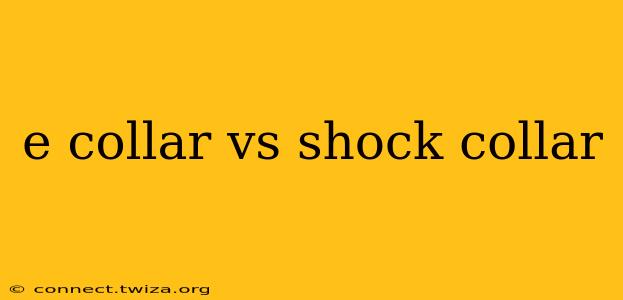The terms "e-collar" and "shock collar" are often used interchangeably, leading to confusion among pet owners. However, there are crucial distinctions between the two, and understanding these differences is vital for responsible pet training. This article will clarify the terminology, explore the functionalities of each type of collar, and help you determine which, if either, might be appropriate for your dog.
What is an E-Collar?
The term "e-collar" is a broad term encompassing a range of electronic training collars. These collars use various methods of stimulation to communicate with your dog, including:
- Vibration: A gentle vibration alerts the dog to unwanted behavior. This is often the preferred method for sensitive dogs or those new to e-collars.
- Tone: A beep or tone signals the dog, providing a warning or cue.
- Static Stimulation (often incorrectly called a "shock"): This delivers a brief, low-level electrical impulse. The intensity is adjustable, and responsible use prioritizes the lowest effective setting. It’s important to note that a properly used static stimulation should never be painful, but rather a corrective signal.
Many modern e-collars offer a combination of these stimulation methods, allowing for customized training approaches tailored to your dog's personality and learning style. The key is control and graduated stimulation. Responsible use involves starting with the lowest level of stimulation and gradually increasing it only if necessary.
What is a Shock Collar?
The term "shock collar" typically refers to e-collars that primarily utilize static stimulation. While all shock collars are e-collars, not all e-collars are shock collars. The term "shock collar" often carries a negative connotation due to concerns about animal welfare. This is largely because of misuse and improper application. Responsible use of any e-collar, including those with static stimulation, requires extensive training and understanding.
Are Shock Collars Cruel?
The question of whether shock collars are cruel is complex. When misused, they can undoubtedly cause pain and distress to the dog. However, when used correctly and ethically by a qualified trainer, the static stimulation can be a valuable training tool. The crucial factor is responsible application, ensuring the lowest effective stimulation level is used, combined with positive reinforcement techniques.
Many animal welfare organizations advocate against the use of shock collars, citing the potential for misuse and the availability of more humane training methods. Ultimately, the decision to use any form of e-collar rests on the owner's responsibility to use it ethically and effectively.
What are the Alternatives to E-Collars and Shock Collars?
Several humane and effective alternatives to e-collars and shock collars exist:
- Positive Reinforcement Training: This method focuses on rewarding desired behaviors with treats, praise, and toys.
- Clicker Training: A clicker marks the desired behavior, followed by a reward.
- Hand Signals and Verbal Cues: Using clear commands and consistent training.
Which Type of Collar is Right for My Dog?
The choice between an e-collar and a shock collar, or indeed any training tool, depends entirely on your dog, your training goals, and your commitment to responsible pet ownership. Consult with a certified professional dog trainer before using any type of e-collar. They can assess your dog's temperament and help determine the best training methods.
How Do I Use an E-Collar Safely and Effectively?
Safe and effective e-collar use necessitates:
- Professional Guidance: A certified professional dog trainer can teach you how to use the collar correctly and safely.
- Proper Fit: The collar must fit comfortably and securely.
- Low-Level Stimulation: Always start with the lowest level of stimulation and gradually increase it only if necessary.
- Positive Reinforcement: Combine e-collar training with positive reinforcement methods.
- Regular Monitoring: Carefully observe your dog's response to the stimulation and adjust accordingly.
Can I Use an E-Collar on All Dogs?
No, e-collars are not suitable for all dogs. Dogs with certain medical conditions may not be good candidates for e-collar training. Always consult your veterinarian before using an e-collar on your dog.
This information is for educational purposes only and should not be considered a substitute for professional advice from a certified dog trainer or veterinarian. Responsible pet ownership prioritizes the well-being of your animal companion. Choose training methods that prioritize kindness, understanding, and positive reinforcement.
